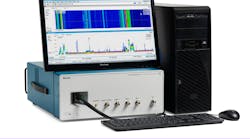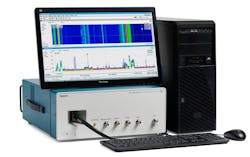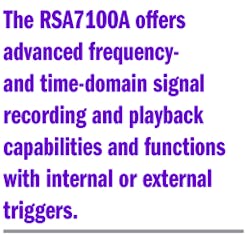Wideband Signal Analyzer Captures 16 kHz to 26.5 GHz
This file type includes high resolution graphics and schematics when applicable.
The RSA7100A wideband signal analyzer is available in versions covering 16 kHz to either 14.0 or 26.5 GHz, with capture bandwidths as wide as 800 MHz.
Communications signal bandwidths are growing wider with time, as users find needs for sending more voice, video, and data through wired and wireless systems. On the military side, radar and electronic-warfare (EW) systems are also employing wider bandwidths. One of the challenges for system developers in all of these areas is to perform wideband signal capture, often for long time periods, in search of transient events.
Fortunately, a test solution was recently introduced by Tektronix: the RSA7100A wideband signal analyzer. It offers a standard real-time capture bandwidth of 320 MHz, which can be optionally extended to as wide as 800 MHz, across a wide frequency range of 16 kHz to 26.5 GHz. The analyzer, with its companion controller and supporting software, is well-suited for wideband communications design, spectrum management, and advanced radar and EW system testing.
For those who don’t need the wide frequency range, the RSA7100A also comes in a version covering 16 kHz to 14 GHz, with the same options for real-time analysis bandwidth. Both lower- and higher-frequency versions tune with 0.001-Hz resolution and are available with a front-end preamplifier for increased signal sensitivity from 10 MHz to 3.6 GHz.
The RSA7100A operates both by displaying measured spectrum in real time and by analyzing data from measurements taken over time. It is actually a measurement system (see figure), teamed with the CTRL7100A controller specially designed for the signal analyzer. Separating the analyzer from the computing engine allows sophisticated signal record, playback, and graphical visualization of signal data.
The controller enables real-time DPX operation with simultaneous streaming of measured data to RAID (redundant array of independent disks) memory. It runs on a Windows-based OS, including generous RAM and removable hard-disk storage for flexibility.
The broadband real-time analyzer employs a stable 10-MHz reference oscillator for stable performance and high-frequency accuracy. The instrument includes a BNC connector for hooking up an external frequency reference source. The single-sideband (SSB) phase noise with the internal reference is a quite respectable −128 dBc/Hz offset 1 kHz from 1-GHz carrier, −134 dBc/Hz offset 10 kHz from the same carrier, and −142 dBc/Hz offset 1 MHz from a 1-GHz carrier.
The instrument’s well-matched input port exhibits VSWR of less than 1.50:1 to 14 GHz and less than 1.70:1 to 26.5 GHz. As much as +30 dBm input power can safely be fed to the input port, and several attenuators are built into the analyzer’s input signal path for controlling input power levels.
Attenuation of 0 to 100 dB is available in 1-dB steps from 16 kHz to 3.6 GHz, and attenuation from 0 to 75 dB can be set in 5-dB steps from 3.6 to 26.5 GHz. In addition, the analyzer’s front end includes a fixed lowpass filter and tunable bandpass preselector filters for image rejection.
Reference levels can be set from −170 to +40 dBm in 0.1-dB steps. For the frequency range of the input preamplifier (10 MHz to 3.6 GHz), the amplitude accuracy (at +25°C) is ±0.13 dB without the preamplifier and ±0.14 dB with the preamp.
The typical displayed average noise level (DANL) without the preamplifier is −156 dBm/Hz from 100 MHz to 1.7 GHz, −154 dBm/Hz from 1.7 to 2.8 GHz, −151 dBm/Hz from 2.8 to 3.6 GHz, −156 dBm/Hz from 3.6 to 14 GHz, −152 dBm/Hz from 14 to 24 GHz, and −150 dBm/Hz 24 to 26.5 GHz. With the preamp turned on, the typical DANL is −164 dBm/Hz from 50 MHz to 1.7 GHz and −162 dBm/Hz from just beyond 1.7 to 3.6 GHz.
The RSA7100A offers advanced frequency- and time-domain signal recording and playback capabilities and functions with internal or external triggers. It can capture real-time events as short as 700 ns in the frequency domain and as short as 4 ns in the time domain, with ±4 ns delay uncertainty.
Triggering functions include Power Level within Span, to look for signals at specific power levels, and Frequency Mask triggering, when searching for signals within a certain frequency range. Power-based triggering can be performed for levels from −170 to +30 dBm, with the level set with 0.1-dB resolution.
The RSA7100A is a powerful measurement tool for any users concerned about broadband measurements or signal activity within a given environment. Together with its controller, the analyzer is meant to operate with a pair of the company’s software packages, DataVu-PC and SignalVu-PC.
DataVu-PC provides the capability to mark events of interest, export waveforms to other formats, and perform pulse analysis and export the data into Pulse Descriptor Word (PDW) file format for further analysis. SignalVu-PC orchestrates real-time spectrum and vector signal analysis, with a host of options for full-featured pulse analysis and analysis of signals with 27 different modulation formats. P&A: $135,000 and up.
Tektronix Inc., 14150 SW Karl Braun Dr., P.O. Box 500, Beaverton, OR 97077; (800) 833-9200
This file type includes high resolution graphics and schematics when applicable.




